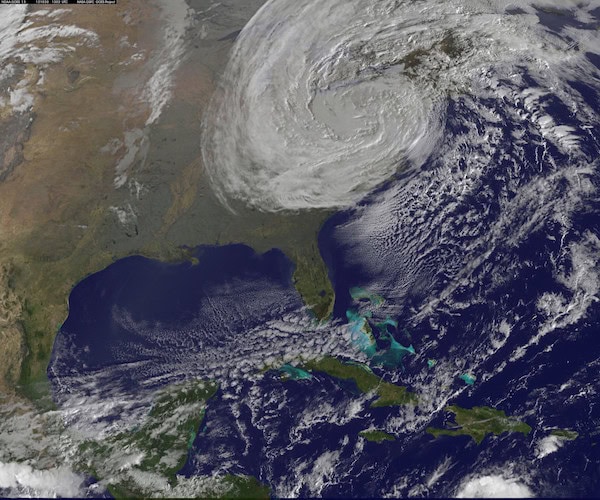
[Image above] 5G promises to connect us to the internet at speeds faster than ever before—but will 5G disconnect us from receiving reliable weather forecasts? Credit: CNET, YouTube
After years of hype, 5G networks are beginning to tentatively open to the public.
In April, three South Korean carriers and Verizon in the United States launched their 5G networks just hours apart from each other (who launched first depends on who you ask), while Britain carriers EE and Vodafone followed with their launches at the end of May and July, respectively. British carriers Three UK and O2 plan to launch their networks respectively in August and October, while the Chinese government is coordinating with three state-backed carriers to bring commercial 5G service to 40 Chinese cities in October.
These first 5G networks will initially operate in conjunction with existing 4G networks, but what makes 5G desirable is its ability to operate at frequencies above those currently used by 4G networks.
4G networks operate in the spectrum of frequencies below 6 GHz. However, as of today, networks strain under current demand in this range, particularly the 700 MHz–2.7 GHz range. 5G networks will help alleviate this crowding by operating in two different bands: a lower frequency below 6 GHz (for long-distance links) and a higher millimeter wave 20–100 GHz region (for super-fast communication in cities). Ideally, 5G will lead to higher data rates, low latency (no delays between transmit and receive signals), and increased connectivity.

Network carriers view frequencies above 6 GHz as an “empty” range to be exploited for 5G, but these frequencies are not as empty as they seem. Credit: IEEE Spectrum, YouTube
Creating devices that operate in the millimeter wave region, though, presents a materials challenge. For example, higher frequencies cannot travel as far and are easily blocked by objects such as buildings, trees, and even books. 5G networks will therefore require much more infrastructure (station towers) and better filtering technologies.
(You can read about some of the ways scientists are tackling these hurdles in the August Bulletin cover story!)
For now, network carriers are most interested in millimeter wave frequencies in the 20 GHz and 30 GHz region because designing materials that can process the lower end of the millimeter wave region is more immediately achievable than designing materials that can process frequencies in the region’s middle or higher end.
But there is a problem with this plan—just because cell service does not use frequencies above 6 GHz does not mean those frequencies are “empty,” specifically frequencies in the 20–30 GHz range.
Weather satellites work by detecting electromagnetic radiation emitted by the earth’s surface and atmosphere. When combined with other forms of information, such as photographs, meteorologists can predict what weather will look like in the near future. This ability is essential to providing adequate warning, for example to areas about to be hit by hurricanes and to predict if the hurricane will be severe enough to warrant evacuation.
While ground and water vapor emit electromagnetic radiation all along the frequency spectrum, water vapor emits relatively strongly at 23.8 GHz. This signal is still weak, though, and requires fine-tuned instruments to accurately pick it up. Nonetheless, this signal is considered extremely important by the weather community.
And this signal is the reason the National Oceanic and Atmospheric Administration, NASA, and other parts of the scientific community currently are embroiled in a fight with the Federal Communications Commission.
In March, FCC began auctioning frequencies in the millimeter wave region to mobile carriers preparing for 5G. And part of the spectrum auctioned by FCC begins at 24.25 GHz.
In theory, signals at 24.25 GHz would not interfere with signals at 23.8 GHz. In practice, signals are like bell curves—a specific frequency has the strongest signal, but the signal tapers off over a range of frequencies.
This frequency spillover could have serious effects on weather forecasting. Acting NOAA administrator Neil Jacobs warned in a House Science Committee hearing on May 16, “[These out-of-band emissions] would degrade the forecast skill by up to 30% … This would result in the reduction of hurricane track forecasts’ lead time by roughly two to three days.”

As a Bloomberg article explains, without water vapor data, models would have predicted Superstorm Sandy heading out to sea. In reality, Superstorm Sandy caused close to $62 billion in damage in the U.S. and at least $315 million in the Caribbean. Credit: NASA Goddard Space Flight Center, Flickr (CC BY 2.0)
A major meeting of the world’s spectrum regulators is set for the end of October, during which limits on out-of-band emissions will be negotiated. An internal United States Navy report warns the U.S. could set a risky precedent: “[I]f the U.S. expands into the 24 GHz band, other countries will follow suit and thus impacts will eventually be worldwide, concentrated near densely-populated areas.”
At this point, how the battle over spectrum allocations will play out is still unknown. What is known is that new materials will need to be developed to help handle these concerns and make 5G networks a tenable reality.
Author
Lisa McDonald
CTT Categories
- Electronics
- Environment


